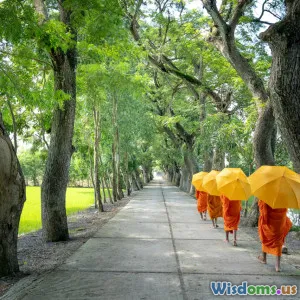
Unexpected Benefits from Digital Detox at Remote Monasteries
9 min read Discover profound effects of digital detox at remote monasteries, transforming mind, body, and soul beyond screen time limits. (0 Reviews)
Unexpected Benefits from Digital Detox at Remote Monasteries
In today’s hyperconnected world where digital devices crowd every facet of life, a digital detox is gradually becoming more than a wellness trend—it is a necessity. But what truly happens when you step away from screens, and not just anywhere, but into the serene solitude of remote monasteries nestled in nature’s lap? These ancient retreats offer an immersive digital detox experience that goes far beyond switching off gadgets.
This article delves into the unexpected benefits rooted in a digital detox carried out at remote monasteries where disconnection from technology meets profound spiritual and psychological practices that have endured for centuries.
The Context: Why Digital Detox and Why Remote Monasteries?
Digital Overload and Its Hidden Costs
The average global adult spends over six hours daily on digital media according to a 2022 Nielsen report. This constant digital exposure leads to issues like digital eye strain, reduced attention span, negative impacts on sleep quality, increased anxiety, and impaired social connections. Digital fatigue can stifle creativity and personal growth, leaving many craving meaningful disconnection.
The Monastic Advantage
Remote monasteries provide isolation, natural surroundings, and a structured routine that encourages mindful presence. Unlike typical wellness retreats that focus on physical pampering or short stints of disconnection, monasteries offer deep spiritual environments designed to harmonize mind, body, and emotions.
For example, the Kopan Monastery in Nepal and St. Davids Abbey in Wales have popularized programs accommodating digital detox seekers—participants report profound insight and emotional balance gains after just a week.
Mental Clarity: Heightened Focus through Silence
The most immediate effect reported during monastery digital detox retreats is heightened mental clarity. Monastic traditions emphasize silence—both external and internal—to calm the mind. Remove the barrage of notifications and multimedia multitasking, and the brain’s cognitive fibers begin untangling.
Neurologist Dr. Lisa Feldman Barrett notes that constant digital interruptions fragment attention and reduce deep processing capabilities. Allowing oneself to reengage with extended periods of focused silence, as practiced in monasteries, supports the restoration and strengthening of executive function.
One retreat participant described the stillness as “a natural reset button—thoughts align like pieces in an intricate mosaic.”
Emotional Resilience: Navigating Feelings without Digital Noise
Monasteries nurture emotional regulation through meditative practices and mindful breathing exercises. When technology is removed, emotional states must be faced directly rather than distracted or numbed with constant scrolling or entertainment.
Research from the University of California shows mindfulness meditation reduces reactivity in the amygdala, the brain’s emotional center. In monastery settings, the supportive community and scheduled rituals ground emotional processing.
This digital detox reveals under-addressed feelings, allowing participants to rediscover equanimity and resilience. As monk Thich Nhat Hanh famously said, "Feelings come and go like clouds in a windy sky. Conscious breathing is my anchor."
Enhanced Creativity: The Quiet Growth of Ideas
Away from the overstimulation of the online world, the mind opens spaces for creative thought to flourish. Historical evidence suggests that notable creatives such as philosopher Blaise Pascal and poet Rainer Maria Rilke sought periods of solitude—which monastery retreats emulate—to escape technological distractions and foster original thinking.
Scientifically, cognitive scientists highlight that default-mode network activity — the brain’s resting state linked to creative insight — increases in environments devoid of constant external input. A 2018 study published in "Creativity Research Journal" confirmed participants undergoing silent retreats scored higher on creative problem-solving tests.
Remote monasteries, surrounded by nature's placidity and ritual, provide optimal conditions to rekindle dormant creative instincts without digital interference.
Physical Benefits: Recalibrating Health and Well-being
Monastic life also naturally incorporates gentle physical activity like walking meditation and mindful chores, contributing to better physical health during the detox.
Disconnection from devices tends to improve sleep by resetting circadian rhythms. According to the Sleep Foundation, screen usage before bedtime suppresses melatonin production, disrupting sleep cycles. At monasteries, falling asleep naturally under starry skies without blue light exposure restores healthier sleep habits.
In addition, absence of technology stress correlates with lower cortisol levels, the stress hormone, positively affecting blood pressure and immune system function. Participants often report sustained energy and reduced exhaustion.
Renewed Social Connection: Human Interaction Without Screens
Paradoxically, disconnecting digitally at monasteries often leads to deeper social bonds. Without phones as social crutches, participants engage authentically through sharing meals, group meditations, and conversations.
A study by the Pew Research Center highlights how screen withdrawal fosters more meaningful face-to-face interactions, improving socio-emotional intelligence.
At monasteries like Tashi Lhunpo in Tibet, communal rituals and shared silence cultivate compassion and empathy—qualities dulled by digital distractions.
Spiritual Awakening: More Than a Pause from Technology
Perhaps the most profound benefit lies in spiritual transformation. While monasteries are rooted in religious traditions, digital detox visitors often report a wider sense of connectedness beyond technological tethering.
Time spent in reflection, prayer, or meditation can reveal deeper questions of purpose and existence. As one monastery retreat guide reflected, “In the absence of digital noise, we hear the quiet voice that connects all things.”
This awakening is not necessarily religious but an awakening to presence, acceptance, and interconnection.
How To Prepare for a Digital Detox at a Remote Monastery
-
Research and Choose Carefully: Consider monasteries welcoming laypeople, such as those in Thailand or the Scottish Highlands, ensuring a supportive environment aligned with your expectations.
-
Set Intentions: Define what you aim to get from the experience—mental clarity, healing, creativity—to focus your energy.
-
Reduce Digital Dependency Gradually: Switch off non-essential devices before arrival to ease transition.
-
Pack Mindfully: Bring simple personal items, comfortable clothing, and a journal for reflections.
-
Honor the Routine and Rules: Monastic life involves discipline—engage respectfully with schedules and practices.
Conclusion: Beyond Disconnection - A Pathway to Holistic Renewal
Digital detoxes at remote monasteries offer more than a break from screens. They present a transformative journey that heightens mental clarity, fosters emotional balance, kindles creativity, promotes physical health, and enriches social and spiritual connectedness.
In a world increasingly defined by digital chaos, the ancient sanctuary of monasteries reminds us how purposeful solitude, mindfulness, and community rebuild the fractured self. The unexpected benefits discovered through these retreats encourage a lasting recalibration of how we interface with technology and ourselves.
Perhaps the greatest takeaway is not the time we unplug but the quality of presence we return to—ready to engage with richer awareness, resilience, and inspiration.
Embark on this rare journey to untangle from screens and rediscover the centered human within.
Rate the Post
User Reviews
Popular Posts

















